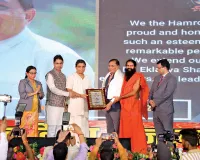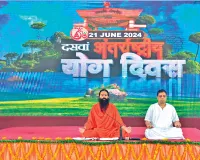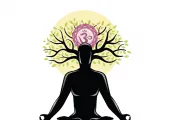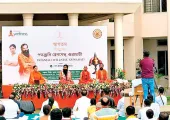Indian Cultural Heritage Rich image
On

Dr. Reena Aggarwal
(Hindi scientist) Patanjali Herbal Research Haridwar, Uttarakhand
Indian culture or 'Dev Sanskriti' has been considered the mother of all the cultures of the world. The meaning of culture is good or improved condition. Culture is the behavior learned by man which he acquires as a social being. It includes a complex totality of knowledge, arts, beliefs, morals, customs, laws and other habits acquired as a member of society. Man's invaluable treasure is his culture, culture is an environment in whose proximity he becomes a social being and acquires the ability to adapt to the natural environment.
Culture is the soul of any country, caste and community. Culture itself reveals all the values of a country, caste or community on the basis of which it determines the ideals and values of life. The simple meaning of culture is family, purification, values, improvement, beauty etc. Indian culture is full of various characteristics.
The oldest
The paintings made in Bhima Batka from the Palaeolithic period in India demonstrate the antiquity of this culture. Similarly, the creation of the world's oldest literature is linked to India in the form of the Vedas. Vedas are the basic source of Indian culture and knowledge-science, it is everything of the Aryans, especially the Vedas have a proud place in the history of Indian civilization and culture. Indian culture is one of the oldest rich civilizations in the world with diversity and rich cultural heritage. Indian culture has always been multifaceted and action-oriented, formed during the great history, unique geography and Indus Valley Civilization and further developed in the Vedic Age, flourishing with the beginning and decline of Buddhism and the Golden Age, its Contains its own ancient heritage. The first rise of civilization in human history was in ancient Mesopotamia in the fourth century BC. Indian culture holds special importance in world history from many points of view and even today, after thousands of years, it is alive in its original form. Cultures of Egypt, Mesopotamia, Syria and Rome have forgotten its original form. The tradition of worshiping the Sun, Moon, Stars, Rivers, Trees and other Gods and Goddesses is still prevalent in India for centuries. Since the excavation of Mohenjodaro, it has come to be considered a friend and contemporary of the oldest civilizations of Mesopotamia.
Material culture and non-material culture
Culture in India is believed to have begun with the Harappan culture in 2500 BC, when the Aryans arrived. Cultural symbols of many social groups and communities are defined by language, creed, religion, caste or race. In Indian culture, along with the Ashram system, the four pursuits like Dharma, Artha, Kama and Moksha have a special place. It was he who established a wonderful coordination of materialism with spirituality in Indian culture. Frugality is a major ideal of Indian culture which is very important in a happy and healthy life.
Different types of cultures are divided into material culture and non-material culture. Culture is divided into material culture where art, architecture and there are technology or material things, whereas in non-material culture Philosophy, Mythology, Literature, Values-Beliefs and Spiritual practices are included. Revival, restoration of holy temples and revival of Indian culture through renewal of the nation is paramount in shaping the power and identity of. of society cultural heritage ideals, values, traditions and shared experiences which increases feelings of unity and purpose.
Incorporation of efforts in Indian culture
The main quality of Indian culture is physical and spiritual elements have to take it along. In ancient times, man's four efforts - Dharma, Artha, Kama, Moksha and four Ashrams - Brahmacharya, Grahastha, Vanaprastha and Sannyasa Ashrams prove this physical and spiritual aspect. The center of Indian culture is Hinduism which is not just a religion but a comprehensive way of life. The ethos of Indian culture is aligned with the principles of Hinduism and its core philosophy of co-existence and 'Vasudhaiva Kutumbakam'. Hinduism has provided the foundation on which various sub-cultures have emerged and evolved over time, contributing to the rich image of Indian cultural heritage.
Indian culture faced challenges from invaders and colonizers whose aim was to destroy its cultural fabric. Islamic invaders targeted temples which were not only places of worship but also wonderful centers of education, art, dance, music and culture. Despite these challenges, India's cultural resilience has stood the test of time.
Diversity in diversity
Indian art, food, lifestyle, costumes, religion, literature, impact of rich image of education, cultural heritage around the world. This is known as the background of cultural diversity. Diversity is the influence of different religions, languages and cultures. But it is. For this reason, food, clothing, heritage and customs diversity is visible in India but still India's cultural the specialties have merged in such a way that their original form has been lost. Difficult to identify clearly. It has also been said, 'We strong because of unity but weak because of diversity are powerful. Similarly, on mankind as citizens neither society nor culture can exist without dependence can live in culture and civilization there is a mutual relationship.
Historicity of civilization and culture makes you aware of your specific characteristics like cities and by urbanization, commercial by skills, monumental structures such as temples, buildings and domes, squares, inheritance and writing identified.
Harmony between spirituality and materialism
Members of any group try to achieve the rules, values and beliefs of their culture by considering it as their ideal of life. In fact, culture emerges from collective experience and establishes the same values, standards, and goals that develop as a result of experiences gained over generations. Vedas are revered, worldly attractions are false, greed for wealth, glory and youth are the cause of destruction. They should be collected only to the extent that is appropriate for religion and necessary for life. Woman is a symbol of motherhood and power, she should be respected, the Guru should be respected, etc. are the ideals of life which we have been trying to assimilate in life for centuries. Emphasis on shared cultural revitalization in revival of culture which were destroyed due to oppression and cultural dominance. The main ways of achieving this revival are the use of holy temples. Restoration and renewal of the cultural heritage of India. There are symbolic stores. Temple Architecture, Education, Spirituality and have been centers of culture that capture the essence of India's rich history are symbols. In the medieval period, Indian culture was influenced by Adi Shankaracharya. Badrinath, Rameshwaram, Dwarka and Puri had consecrated four Dhams named. in all four corners of India the cultural unity and integrity of the country is inherent.
Since last years, as a result of cultural awakening under the leadership of Prime Minister Narendra Modi, concrete efforts are being made to revive and restore these temples. Prime Minister Modi's initiative reflects his deep commitment to rejuvenating India's cultural heritage. Construction of Ram temple in Ayodhya, Mahakal and Kashi Vishwanath corridor in Ujjain, Kedarnath beautification and many such projects are living examples which symbolize the overall revival of cultural nationalism and pride.
Universality
Indian culture has a global outlook and believes in the concept of 'Vasudhaiva Kutumbakam' i.e. the whole world is one family. Thus, the concept of coexistence is established not only within geographical and political boundaries but also outside them. The cultures of other countries are getting destroyed with the flow of time but Indian culture has been maintaining its traditional existence since ancient times culture of human needs fulfills and inspires to satisfy the two basic needs of man like food and sexual satisfaction in a free and decent manner. The first form is an indicator of extreme barbarity which is self-indulgent and the second is an indicator of a dignified form of culture which has developed as a result of social experience of generations, monogamy, which is the best means of better fulfilling the interests of the group.
In conclusion, it can be said that Indian culture is rich with many characteristics which even today provides consciousness of the highest values and ideals to the entire Indian society. Ultimately, study, teaching and contemplation of Vedas is absolutely necessary to understand the entire aspects of Indian civilization and culture. In this form, human being, society and culture are dependent on each other. Hence, it is clear from these facts that while on one hand our behavior is influenced by the society, on the other hand the ideals of culture pave the way for human life.
लेखक
Related Posts
Latest News
01 Nov 2024 17:59:04
जीवन सूत्र (1) जीवन का निचोड़/निष्कर्ष- जब भी बड़ों के पास बैठते हैं तो जीवन के सार तत्त्व की बात...









.jpg)











